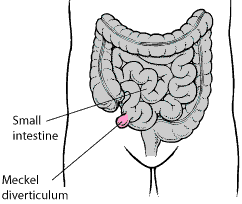 A Meckel's diverticulum is one of the most common congenital digestive system disorders. This means a child already has it when they are born. A Meckel's diverticulum is a small pouch formed in the wall of the intestine near where the small and large intestines meet. A very small number of people have a Meckel's diverticulum. Most of those people do not even know, have no problems and it does not harm them. No one knows why the diverticulum bothers some people and not others.
A Meckel's diverticulum is one of the most common congenital digestive system disorders. This means a child already has it when they are born. A Meckel's diverticulum is a small pouch formed in the wall of the intestine near where the small and large intestines meet. A very small number of people have a Meckel's diverticulum. Most of those people do not even know, have no problems and it does not harm them. No one knows why the diverticulum bothers some people and not others.
Meckels Diverticulum
Information on Meckel's diverticulum, its symptoms, diagnosis and treatment options at Children's Wisconsin
About
How Does It Affect My Child?
While most people with a Meckel's diverticulum never have any health issues from it, some individuals may experience a range of symptoms, including nausea, vomiting, or other digestive problems. These symptoms typically arise when complications occur, such as bleeding, infection, or a blockage in the intestines. Bleeding is often caused by an ulcer that forms when the diverticulum secretes acid, much like the stomach does. This acid can harm the intestinal lining and lead to significant bleeding, which may be visible in a child's stool. When this happens, it is crucial to seek immediate medical attention.
An infection of the Meckel's diverticulum is characterized by sudden, severe abdominal pain and a fever. Unlike typical stomach aches, this pain is persistent. Some children might also experience nausea and vomiting. Doctors can often diagnose an infection using an ultrasound or CT scan. If the diverticulum causes an intestinal blockage, it's usually due to the intestine twisting around it. This prevents food from passing through, leading to severe cramping, nausea, and vomiting. Both infection and obstruction often require surgery to remove the problematic diverticulum.
To determine if a Meckel's diverticulum is causing these symptoms, doctors may perform several tests. For bleeding, a specialized X-ray called a Meckel's scan can be done. This test involves injecting a substance into a child's IV that highlights the diverticulum on the X-ray if it contains acid-producing tissue. If a more direct look is needed, a surgeon may use a small camera, called a laparoscope, inserted through the belly button to examine the intestines. If the diverticulum is found, it can often be removed during the same procedure to resolve current problems and prevent future ones.
When Should My Child Have Surgery?
Any patient that presents with complications from a Meckel's diverticulum we will recommend surgery to remove the Meckel's diverticulum. Surgery is typically recommended during the hospital stay that brought your child to the hospital.
What To Know Before My Child’s Surgery
Your child will have an IV (intravenous tube) put into a vein in your child's hand or foot. The IV will give your child fluid and if they are having bleeding may be used to give blood. These fluids will keep your child from getting dehydrated and keep your child safe. A doctor or nurse may put a tube, called a nasogastric or NG tube, down your child's nose and into the stomach. This tube will drain the stomach and may prevent vomiting. The drainage may be clear, brown, yellow or green. IV antibiotics may be given to reduce the risk of infection after surgery.
What Is Done During Surgery
Your child will need to have general anesthesia for the surgery. Your child will be given medicine to make them comfortable and forget about most things during the surgery. Surgery is done either by a laparoscopic (with the camera) or open approach. The laparoscopic way involves making three to four small (<1cm) incisions, or cuts, in the belly area. We can place a camera and small tools to identify the Meckel's diverticulum into those incisions. In some patients, the laparoscopic surgery may not be possible and your surgeon may recommend an open surgery. This is a surgery that needs a larger incision. During the surgery the surgeon will remove the Meckel's diverticulum and sometimes a very short part of the adjacent intestine.
What Care Will My Child Need After Surgery?
- Your child will be given pain medicine after surgery to keep them comfortable.
- Your child will be asked to take deep breaths, cough and sit in a chair.
- Your child will be helped to walk after surgery. This helps prevent pneumonia. Babies may be held.
- A urinary catheter (tube) may be put in your child's bladder during surgery to empty it. Your child may also need this tube after surgery.
- Your child may not be able to drink anything right after surgery. An IV will still be needed to give fluids.
- The NG tube may be needed to empty your child's stomach. It will be removed when your child's stomach starts to growl and your child starts to pass gas. The doctors will tell you when your child can then drink and eat.
Our Locations
Our Doctors
At Children's Wisconsin, our doctors are 100% committed to the health and well-being of kids. They care for every aspect of a child's health, including their physical, social, dental and mental well-being. We are a community of dedicated professionals who shares an unwavering passion to care for kids whenever and wherever they need us.




